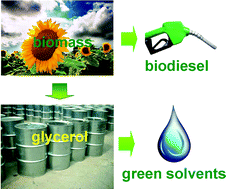Glycerol as a sustainable solvent for green chemistry
Abstract

* Corresponding authors
a
Institute of Physical Chemistry and Industrial Catalysis, Hubei Key Laboratory of Material Chemistry and Service Failure, Huazhong University of Science and Technology, School of Chemistry and Chemical Engineering, Huazhong University of Science and Technology (HUST), 1037 Luoyu road, Hongshan District, Wuhan, China
E-mail:
klgyl@hust.edu.cn
Fax: (0)86-(0)27-87 54 45 32
b
Laboratoire de Catalyse en Chimie Organique, Université de Poitiers/CNRS, 40 avenue du recteur, Pineau, Poitiers, France
E-mail:
francois.jerome@univ-poitiers.fr

 Please wait while we load your content...
Something went wrong. Try again?
Please wait while we load your content...
Something went wrong. Try again?
Y. Gu and F. Jérôme, Green Chem., 2010, 12, 1127 DOI: 10.1039/C001628D
To request permission to reproduce material from this article, please go to the Copyright Clearance Center request page.
If you are an author contributing to an RSC publication, you do not need to request permission provided correct acknowledgement is given.
If you are the author of this article, you do not need to request permission to reproduce figures and diagrams provided correct acknowledgement is given. If you want to reproduce the whole article in a third-party publication (excluding your thesis/dissertation for which permission is not required) please go to the Copyright Clearance Center request page.
Read more about how to correctly acknowledge RSC content.
 Fetching data from CrossRef.
Fetching data from CrossRef.
This may take some time to load.
Loading related content
